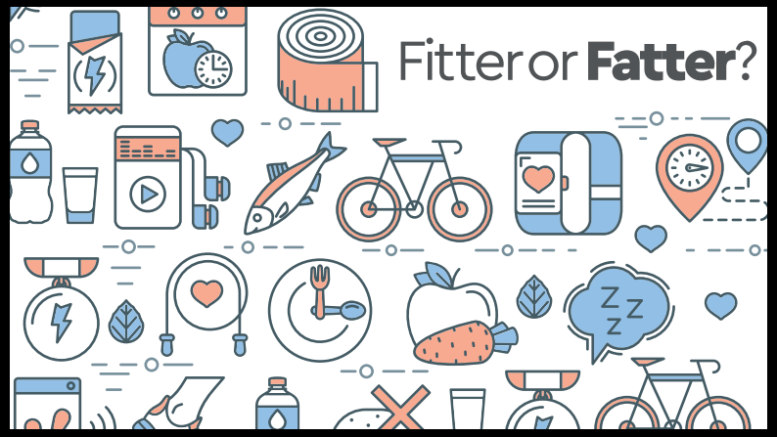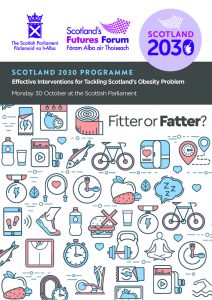On Monday 30 October 2017, Scotland’s Futures Forum and the Scottish Parliament Information Centre brought together MSPs, academics and other stakeholders to look to 2030 and beyond and explore the policies that will make the biggest difference in tackling Scotland’s obesity problem.
Looking at education and urban planning as well as the health impacts of obesity, the seminar took a broad and long-term approach to one of Scotland’s major challenges.
Introduction
Neil Findlay MSP, Convener of the Health and Sport Committee, welcomed participants to the seminar on tackling Scotland’s obesity and outlined the approach to be taken.
With a deliberately widely drawn group of participants – MSPs from the Health and Sport Committee, MSP researchers, Parliament staff, academics, health practitioners and other interested parties – the event had three parts:
- Short presentations to set the context and provide some information on the breadth of policies that could help tackle Scotland’s obesity problem.
- Breakout sessions in which different groups would consider different policy approaches with reference to their potential effect on an imagined family.
- Feedback from those sessions brought together to establish themes and look for next steps
This seminar also helped inform the Parliament’s scrutiny of the 2018 Scottish Government obesity strategy.
Presentations
Kate Grant – Scottish Parliament Information Centre
View Kate’s slides on research into obesity in Scotland
Kate Grant stated that 29% of adults living in Scotland are clinically obese and that interventions are needed now to reduce obesity. The event therefore would focus on the question: What interventions does Scotland need to introduce now in order to reduce obesity by 2030?
“There is no one miracle cure for obesity”
The breakout groups would discuss the four most popular interventions from a survey of academics conducted by SPICe earlier in the year.
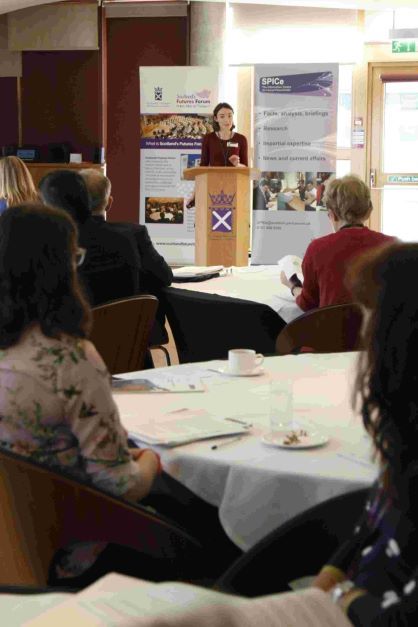
The choice of interventions was designed to stimulate the debate, as the survey indicated that – as highlighted by many others – multiple interventions need to be introduced now, in order to meaningfully reduce obesity by 2030.
Professor Paul Haggarty – Rowett Institute of Health and Nutrition
View Paul’s slides on obesity issues facing Scotland over the next 15-20 years
Professor Haggarty spoke about the obesity issues facing Scotland over the next 15 to 20 years.

He noted the significant and growing economic, health, wellbeing and social costs related to obesity. Public Health England estimated that the annual spend on the treatment of obesity and diabetes in the NHS is greater than the amount spent on the police, fire service and judicial system combined. The UK-wide NHS costs attributable to overweight and obesity are projected to reach £9.7 billion by 2050, with wider costs to society estimated to reach £49.9 billion per year. For Scotland the estimate is £4.6 billion.
In 2015, 68% of men and 61% of women in Scotland were overweight or obese (25% and 29% respectively were obese). Professor Haggarty showed the results of recent global modelling, which demonstrates a steep rise in mortality with any increase in Body Mass Index (BMI) above healthy levels, and how this related to the Scottish BMI distribution.
Obesity rates have been relatively stable since around 2009, but the nature of obesity is changing. Younger generations are becoming obese at earlier ages and staying obese into adulthood. The increase in obesity incidence before 2009 has yet to fully manifest in poor health as many chronic diseases take decades to develop. We are therefore likely to see increases in obesity related ill health for some time.
Professor Haggarty noted the striking link between deprivation and obesity levels, particularly in women, and emphasised the importance of maternal obesity and the increasingly transgenerational persistence of obesity. A child with an obese parent is significantly more likely to be at risk of being overweight or obese (40% compared with 22%) or at risk of obesity (23% compared with 11%). Obese mothers give birth to heavier babies who, in turn, have a greater risk of premature death in adulthood.
“Obese mothers give birth to heavier babies who, in turn, have a greater risk of premature death in adulthood”
He concluded by noting that a reduction in BMI at any level above the normal range will produce health gains. For short term gains, he suggested a focus on deprived groups, while the long-term strategy should focus on the early years and pregnancy to stop future generations perpetuating the problem of obesity.
Lorna Aitken – Education Scotland
View Lorna’s slides on the work under way to embed healthy food habits into the school curriculum
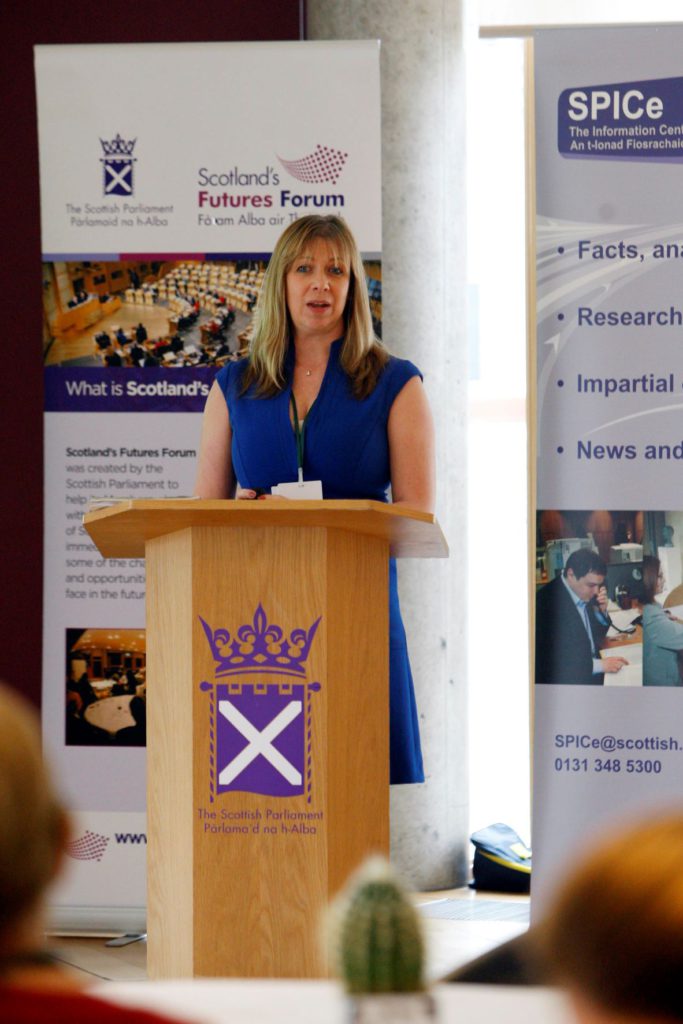
Lorna Aitken spoke about the work under way to embed healthy food habits into the school curriculum
Scotland is at a critical point with a review of both the Scottish Government’s obesity strategy and the regulations on school nutritional standards. She provided some historical context to the place of food and nutrition within schools, including the relatively recent inclusion of any consideration of food education and a link to the catering provided in schools. Welcome work is now under way through the Food for Thought and Developing Scotland’s Young Workforce initiatives.
However, in the Scottish Education Survey, primary schools referred to a lack of: onsite facilities; staff training and confidence to deliver practical cookery; time to plan and prepare practical cookery; and funding for food experiences. In secondary, there was a critical staffing situation, a lack of funds to deliver the curriculum entitlement, a problem with the image of the subject and time barriers for delivery of sessions. As Ms Aitken asked, who could effectively teach a class of pupils to cook a meal from scratch and clean up afterwards in 50 minutes?
“How can we expect our Home Economists to effectively teach cooking skills and clear up in 50 minutes?”
Ms Aitken then gave her views on what school food and food education should look like in 2030. She hoped that practical cookery would be mandatory as part of initial teacher education, that all schools would embed a whole-school approach to school food and food education, and that schools would prioritise health and wellbeing based on measures around school food and food education.
Ms. Aitken also suggested that by 2030 all young people should leave school with a bank of food skills and recipes (they should have 5 recipes by 5 years old and 11 recipes by 11 years old etc). She hoped that schools would have the necessary resources, funding and equipment to deliver practical cookery, that food technologists and/or scientists would no longer be scarce in high schools and that the subject would be appealing to all young people.
Heather Peace – Head of Public Health Nutrition, Food Standards Scotland
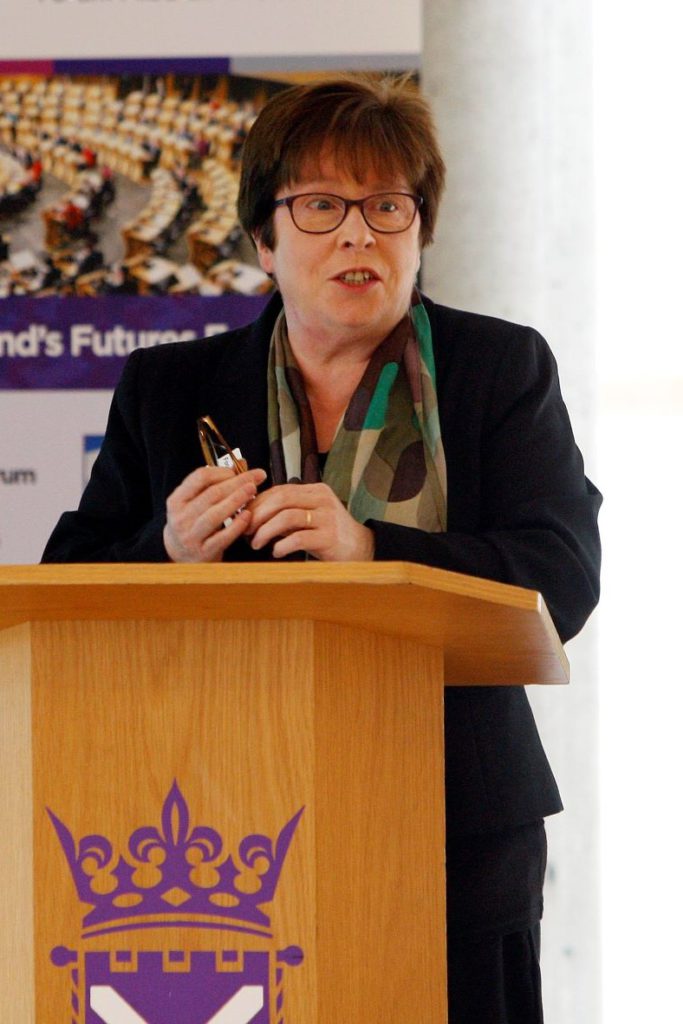
Heather Peace talked through the role of Food Standards Scotland and the scope of its work over the next 15 to 20 years to address obesity.
Food Standards Scotland (FSS) is Scotland’s food body responsible for food safety, food authenticity and nutrition. Uniquely, it has a duty under to improve the extent to which consumers have diets conducive to good health, and this takes FSS into the debate about improving Scotland’s health.
In January 2016, FSS proposed a package of measures to Scottish Government ministers on how to tackle obesity.
The recommendations, based on analysing the available evidence, including from the FSS dietary surveillance programme, fell into two broad categories: education and the food environment.
Education and the provision of evidence-based advice is a core function of FSS. It provides advice on diet and health to consumers, ministers and stakeholders, and it contributes to nutrition education via schools, in collaboration with health professionals and via consumer campaigns. However, education alone will simply not be enough.
“The food environment that surrounds us is set up to make us eat the discretionary food and drink that unbalances our diets”
The food environment that surrounds us – be it on the high street, in shops and restaurants, in the media or online – is set up to make us over-eat the discretionary food and drink that unbalances our diets. Faced with an obesogenic environment, it’s hard for a great many of us to make the healthiest of food and drink choices.
In order to improve the food environment for consumers, FSS recommended a number of actions to make choosing healthy food and drink easier:
- Tackling the marketing and promotion of high fat, salt and sugar (HFSS) food and drink
- Taxation of HFSS beyond the levy on sugary soft drinks
- Reformulation of food and drink to remove excess calories, sugars, fats and salt
- A strategy to tackle out-of-home food and drink consumption
- Influencing the food environment, especially in the vicinity of schools, through local licensing and planning
- Support for Scottish businesses to make the changes needed
Ms Peace finished by noting that we are on a journey with poor diet and obesity and that, right now, we need brave and bold action – not just by FSS, the Scottish Government and partners but also by the UK Government and more widely across the globe. Health professionals, educators, consumers and the food and drink industry all have a part to play.
Dr. Caroline Brown, Heriot-Watt University
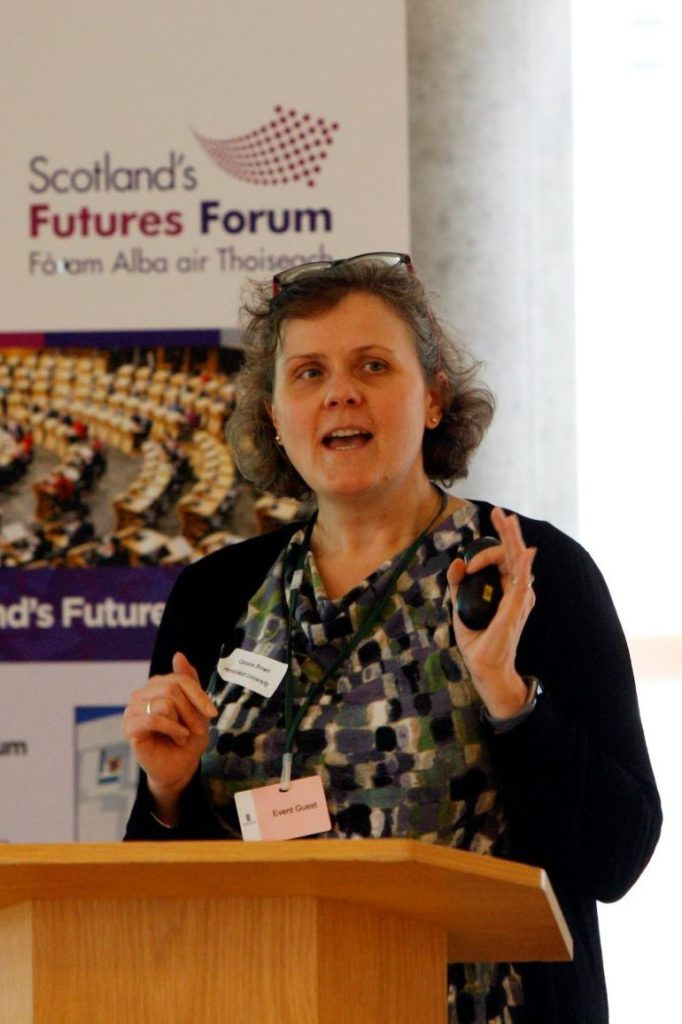
Dr. Caroline Brown spoke about how urban planning to encourage physical activity can best be implemented to address obesity in Scotland.
She contrasted the treatment and position of walking and cycling in Scotland, and she suggested that big changes are needed. Walking has the highest priority in Scottish Planning Policy, and extensive walking infrastructure exists in Scotland. A significant proportion of trips are made on foot, although walking is usually part of longer journey.
In contrast, although cycling is the second highest priority in policy, there is little dedicated infrastructure and only a small
proportion of trips are made by bike. Indeed, cycling conditions deter the vast majority of the population from cycling.
There is hope, and the strategies adopted in Seville between 2006 and 2011 are an example of what can be done. An increase in segregated cycle ways from 12km to 164km led to an increase in cycle trips from 3.0 million to 16.3 million per year. Cycling now accounts for around 6% of all trips.
Small and relatively subtle changes to the physical environment can make difference. New cycle paths typically generate 20% increase in cyclists from day one.
“New cycle paths typically generate a 20% increase in cyclists from day one”
In Waltham Forest, London, the Mini-Holland project of street improvements brought in space for pedestrians and cyclists, changed priority at junctions to pedestrians and cyclists, and involved tree planting and seating. A 2016 resident insight survey found that 17% said they cycle, compared to 12% in 2015, while 73% said they cycle at least once a week, up from 62% in 2015.
Urban development should therefore design in and measure walkability. Paths and tracks should be convenient, convivial, connected, comfortable and conspicuous.
Dr. Brown’s conclusions were that Scotland should:
- Spend money on good-quality infrastructure rather than training.
- Revise design and policy guidance to give pedestrians and cyclists actual priority.
- Develop green infrastructure and tree planting.
- Ensure community engagement, so that people are asked “How can we make your streets nicer?”
Scenario discussion
Participants broke into four groups to discuss the issues further. Each group received a scenario relating to one of four members of the same family: Calum, Holly, Carol and Jim.
The scenario outlined what was likely to happen to the family member if nothing changed for them. The groups were asked to consider the impact of each intervention on changing the described outcomes for their family member.
The Family
Calum, a five-year-old boy
2017: Starting primary school, Calum is already overweight but not obese. He has a poor diet, high in energy and low in nutritional foods.
2030: Calum is 18. He has slimmed down but retains bad eating habits. He plays football whilst at college, but remains unhealthy due to a lack of good nutrition.
2050: Calum is 38. He has an office job, which means that he is inactive and is prone to unhealthy snacking. He lives five miles away from his office and he drives to work. Calum has three children and is classed as obese due to a combination of bad diet and lifestyle choices. He has a bad back and he frequently goes to the doctor about it, as well as about respiratory issues.
Holly, a 14-year-old girl
2017: Holly is at high school. Although she is not overweight, she does not do much physical activity. She does not eat school meals due to the price but instead purchases lunch from the nearby town. She is unaware that a lack of good nutrition can lead to health issues.
2030: Holly is 27. She has put on 7kgs after her first child and a further 10kgs after her second. She does not breastfeed, and Holly has been unable to lose this weight as looking after the children means she cannot exercise. The price of healthy food prevents a change in diet.
2050: Holly is 47. She was diagnosed with obesity-related breast cancer and had to undergo a double mastectomy.
Carol, a 38-year-old woman
2017: Carol is the mother of three children under 10. She is an obese previous smoker who has been identified has being one of the many Scots at risk from type 2 diabetes.
2030: Now 51, Carol was forced to take early retirement due to obesity-related health issues. She was aware of the health risks of being overweight, but embarrassment about her weight has meant that she has been reluctant to attend the gym or local slimming groups.
2050: Carol is 71 and still obese. She is unable to help with childcare for her grandchildren. She is too old to qualify for gastric band surgery and is beginning to find that her size is limiting her ability to leave the house.
Jim, a 62-year-old man
2017: Jim has been obese since his wife died when he was in his mid-fifties, as she did most of the cooking in the household. He has been relying on ready meals and was diagnosed with type-2 diabetes three years ago.
2030: At 75, Jim is still obese and now blind due to diabetes. He was moved into a care home as he was unable to provide for himself and was isolated due to weight related restricted mobility.
2050: Jim passed away in 2032 as his obesity and high blood pressure resulted in him having a fatal heart attack at the age of 77.
The four interventions

- Facilitate walking and cycling, by changing the built environment. People in Scotland do not get enough physical activity. Even though 50% journeys are less than 3 km and 25% journeys are less than 1 km, only 20% journeys made by foot and 1% of journeys made by bike. Facilitating walking and cycling may improve activity levels.
- Provide free or subsidised healthy school meals. Scotland does not eat enough fruit, vegetables, fibre or oily fish, and it eats too much fat, sugar and too many calories. Schools form a large part of children’s ‘food environment’. Currently, there are minimum nutritional standards for meals in Scottish public schools, and some children are eligible for free meals. Expanding the provision of healthy school meals may improve children’s diet.
- Reduce cost of healthy food and drink by adding agricultural subsidies. Scotland does not eat enough fruit, vegetables, fibre or oily fish. Healthier diets may cost more than less healthy diets, and deprived households must use a greater proportion of their income to buy food. Introducing agricultural subsidies may reduce the cost of fruit and vegetables. This may encourage greater consumption.
- Reformulate food and drink products through Government regulations. Scotland eats too much fat, sugar, salt and too many calories. Too much comes from ‘discretionary’ items. Reformulation involves altering food or drink products to limit the amount of sugar, fat, salt or calories. Both the UK and Scottish Governments have run voluntary reformulation programmes, which have by criticised by some. Requiring reformulation through government regulations may improve Scotland’s diet.
What might work for the family?
Change the built environment
There was agreement that Scotland needs to increase physical activity in daily life, and changing the built environment is a positive way to reduce health inequalities.
Improvements to pavements and road priorities for cyclists and pedestrians in all areas would enable more people to be active, especially parents negotiating journeys with buggies and young children. However, the issues are different in rural and urban areas, and changes could be harder to implement in rural areas.
Making parks and green spaces more accessible, with all school playgrounds becoming open playgrounds that are available out of school time, would enable children like Calum and Holly to lead more active lives.
It was suggested that pride in her surroundings might lead Holly to take more pride in herself – self-esteem is key. As Holly gets older, a healthier environment might help her children become more active, and she may go outdoors more with them because of that.
Infrastructure that encourages people to walk would also enable more social prescribing, which could prevent Carol and Jim from becoming increasingly house-bound and socially isolated as they age.
It is important to involve local community groups and ensure that developments encourage a neighbourhood community and enable the use of local services.
Overall, it was noted that healthy infrastructure needs more resourcing, and not enough is currently spent to make a difference.
Free or subsidised school meals
The provision of school meals has not been proven to have an effect, as there are too many external factors that can also influence behaviour.
However, there was agreement that school meals help embed culture of eating together and give Calum and Holly guidance on what a meal should look like in terms of size. Both improvements could feed through into adulthood and influence their behaviour when they become parents.
School meals are also conducive to better education, which has knock-on benefits to health, and their provision would give Carol more money in the household budget.
Conversely, school meals aren’t always healthy and the choice isn’t always good. Any roll-out would need to consider the nutritional and energy values of the meals themselves.
Overall, it was noted that school meals could provide benefits but can’t solve everything.
Reduce relative price with agricultural subsidies
This intervention could provide a benefit as Carol will be looking at value for money when shopping, while decreases in price could enable Jim to supplement his ready meals with healthy snacks.
Subsidy might allow agriculture and horticulture industries to invest in new crops and techniques to broaden the range of healthy food available. It might also enable healthy eating/food growing schemes in deprived areas.
However, the benefit would depend on whether the price decrease fed through to the local shops Carol and Jim shop in. Equally, the UK is currently a net importer of food goods, so this policy might not make much of a difference, unless the UK grows more of its own food and people become reaccustomed to eating fresh food in season.
With Brexit, there is an opportunity to look at all the subsidies provided and to avoid perverse incentives. It is therefore an idea worth investigating.
Reformulation of food through government regulation
This policy could have the biggest effect as it would make it easier for people to change to healthier foods, but they would remain passive, uninformed and unengaged citizens.
Reformulation could help with ready meal nutrition and if it is done well it should have an impact on every family member. Reformulation could also help to encourage or enforce care home and school meal nutritional regulations.
Reformulation could prevent weight gain in Calum and Holly and change their palates – although not in relation to sweetness if artificial sweeteners replace sugar. It might also help their educational attainment, dental health and general well-being at crucial times.
The policy would make it easy for Carol and Jim, who wouldn’t need to change their behaviour. It was questioned whether this was a good or bad thing. It would also be only a slight improvement: individuals would still need support.
If enacted, reformulation should be more nutritious, not simply lower in fat, sugar and salt. It should avoid calorie fundamentalism that focuses solely on calorie intake, and it should include regulating the portion size of ready meals to prevent processors from bulking up with nutrient-empty ingredients.
Regulation is complex, but participants agreed that voluntary reformulation has not been very successful and can go only so far. There will need to be a willingness to take on the manufacturing, processing and retail sectors.
Discussion
What action should be taken at a national level to tackle and prevent obesity?
Participants agreed that multiple interventions were required: that was acknowledged from presentations and reinforced by the workshop session. Poverty reduction is also key because of the links between obesity and deprivation.
The four suggested interventions, although not perfect, were seen to be good as they could impact all three phases in the obesity journey: prevention, weight loss and weight management, as well as three transitional periods – school, adolescence to adulthood, and pregnancy.
One advantage of the suggested interventions was that they were passive: the general public would not need to take any real action to participate and see the changes. However, how much do we need to change individuals’ behaviour? With that in mind, the following themes and questions emerged from the feedback.
Our environment
The environment in which we live has to make eating healthily and being active the easiest option. In addition to encouraging active travel, eating healthily must be made simple, affordable and accessible, with healthy food available in the shops and outlets that people use.
In effect, this means measures such as taxes on sugar and energy density, with a system akin to minimum alcohol pricing to promote reformulation and increase the relative price of high fat, salt and sugar foods.
Price promotions would need to be addressed, preventing super sizing, and supplements that deliberately stimulate hunger and thirst should be banned.
We should also increase the information to people through useful labelling, including for food from restaurants, cafes and takeaways.
Planning rules and taxation should be used to increase prevalence of healthy food outlets in deprived areas and to decrease the prevalence of unhealthy food outlets generally.
What is the balance between local and national government in pushing for healthier environments, in terms of both active travel and food outlets?
How do different policy portfolios compete? For example, planning and licensing regulations tend to be about stimulating economic growth and trade rather than prioritising public health.
Other ideas included:
- developing a supply chains scheme to get locally grown healthy food into convenience stores, using subsidies if needed
- a multiple retailers and caterers levy – tax these businesses for the ‘health difference’ between what we are sold and what we should eat. For example, if 14% of calories brought into home are sugars against the recommended 5%, the 9% difference is taxed, with the levy paid by retailers and caterers based on reporting of their sales.
Finally, out-of-school outlets should at least be restricted by planning regulations. Indeed, many participants were unable to leave their schools to get food when they were younger. Why don’t we ensure that children access healthy food options by keeping pupils within school grounds for the school day?
Our behaviour
Habitual practices can be hard to change, and it must be made as easy for people as possible.
However, it was argued that for some people it is too late to make any changes to lifestyle, and there was caution regarding public health programmes aimed at adults as most of them knew what they should and should not be doing and eating, but did not follow the advice.
The following questions occurred: Should this be about “health through stealth”? Should the general public be aware of what is happening and do they need to be active participants? Not all the public have been on board with tobacco and alcohol regulation but upon reflection most now agree with the steps taken. There certainly needs to be a level of public involvement in the process, but do the public need to be in agreement with the efforts to tackle obesity?
There is an increasing amount of data available on peoples’ behaviour, including shopping choices, activity and diet. Devices such as fitness trackers and smartphones provide a wealth of information, albeit mostly to the private sector. What role is there for technology? How can the information it produces be used to inform policy decisions?
Our culture
To make a big difference, we would have to change our social norms, but the current Scottish culture is difficult to change.
One challenge is to find a new way to talk to people about their weight; it is culturally difficult to discuss. Medical staff and others can be embarrassed about their own weight and worried about people’s response if they try to discuss the issue. Equally, we need to address the stigma of obesity to prevent social isolation in those who are obese. Indeed, some suggested that the title of the event “Fitter or Fatter?” could be unhelpful in that “fatter” is offensive to some people with obesity.
There is no suggestion that Scottish culture will change to be healthier any time soon, so action is needed with consideration of how public messages are conveyed. Should we start the conversation with health professionals, with measures to support weight reduction and healthy diets? How do we encourage people to maintain a healthy weight without stigmatising people who are obese?
We also need social and cultural encouragement for people to learn food and cooking skills. How can we enable people to learn how to cook?
We also need acknowledgement of the psycho-social aspects of obesity that aren’t addressed by much discussion of the topic and how it should be tackled. People’s emotional relationship with food is important, as is how social and environmental factors affect how/why people buy and consume different foods. How can legislation, policy and regulation stimulate culture change? What else is needed?
Leadership
There is a challenge of competing narratives, a strong industry and some media bias in how issues are reported. Leadership and bravery will therefore be vital, particularly from the Scottish Government.
The state should be bolder in its actions to drive culture change. If evidence from elsewhere shows that interventions have produced the right outcomes, the Government and others should rebuff accusations of operating ‘nanny state’.
For example, there is a need for stronger interventions from public services at high risk times, such as pregnancy, with GPs, midwives and health visitors all involved before, during and after birth. Breastfeeding is positively associated with the healthy weight and general health of mothers and their children, but Scotland’s breastfeeding rates remain very low compared with Scandinavian countries.
Legislation can also drive higher nutritional standards, but we have to beware of industry twisting rules and finding loopholes to exploit. Does Scotland have the motivation to tackle the culture and system that leads to our obesity problem?
Obesity is not just a health issue, so there is a challenge to ensure policy areas communicate with each other. How do we sell the public health view to other sectors? Are we aware of the conflicting priorities across policies? How can we reconcile them?
Finally, although the efforts will be driven from the centre, local communities have to be engaged in the work. What role is there for local communities, ensuring that things are done with them rather than to them?
Closing remarks
Ivan McKee MSP, Health and Sport Committee
Mr. McKee MSP drew the seminar to a close by thanking participants for their contributions. The seminar and report, including the major themes and the questions, would support the Health and Sport Committee’s work on obesity, including in scrutinising the Scottish Government’s forthcoming obesity strategy.
Participant List
| Lorna | Aitken | Education Scotland |
| Rebecca | Bell | Office of Alex Cole-Hamilton MSP |
| Mark | Birkin | Consumer Data Research Centre, University of Leeds |
| David | Blane | Academic Fellow in General Practice, University of Glasgow |
| Iain | Broom | Centre for Obesity Research & Epidemiology, Robert Gordon University |
| Caroline | Brown | The Urban Institute, Heriot-Watt University |
| Amanda | Brown | Kantar Worldpanel |
| Lizzy | Burgess | Scottish Parliament Information Centre |
| Georgina | Cairns | Independent Consultant on Public Health Policy and Behaviour Change |
| Stephanie | Chambers | Institute of Health and Wellbeing Social Sciences, University of Glasgow |
| Ben | Chiu | Cancer Research UK |
| Sally | Cowburn | Office of Alison Johnstone MSP |
| Fiona | Denison | MRC Centre for Reproductive Health, University of Edinburgh |
| Stephan | Dombrowski | Centre for Health & Behaviour Change, University of Stirling |
| Ishani | Erasmus | Scottish Parliament Information Centre |
| Neil | Findlay MSP | Health and Sport Committee |
| Heather | Galway | Health and Sport Committee Clerk |
| Rumandeep | Gill | British Soft Drinks Association |
| Kate | Grant | Scottish Parliament Information Centre |
| Paul | Haggarty | Rowett Institute of Nutrition and Health, University of Aberdeen |
| Claire | Hislop | Diet & Obesity Prevention, NHS Health Scotland |
| Anne | Jepson | Scottish Parliament Information Centre |
| Sandra | MacRury | Head of Rural Health and Wellbeing, University of the Highlands and Islands |
| Lynsay | Matthews | MRC/CSO Social and Public Health Sciences Unit, University of Glasgow |
| Erin | McGinley | Scottish Parliament Information Centre |
| Ivan | McKee MSP | Health and Sport Committee |
| Jack | Middleton | Office of Jenny Gilruth MSP |
| Colin | Moran | Physiological Epigenetics Research Group, University of Stirling |
| James | Niven | Scottish Government |
| Celia | Nyssens | Nourish Scotland |
| Chris | Oliver | Physical Activity for Health Research Centre, University of Edinburgh |
| Heather | Peace | Food Standards Scotland |
| Neil | Purdon | Scottish Food and Drink Federation |
| Valeria | Skafida | Q-Step Centre, University of Edinburgh |
| Laura | Stewart | Weight Management and Diabetes, NHS Tayside |
| Innes | Taylor | Scottish Conservative Party |
| Joyce | Thompson | Dietetic Consultant in Public Health Nutrition, NHS Tayside |
| Maree | Todd MSP | Health and Sport Committee |
| Lorraine | Tulloch | Obesity Action Scotland |
| Steve | Turner | Royal College of Paediatrics and Child Health/University of Aberdeen |
| Colin | Smyth MSP | Health and Sport Committee |
| Meg | Whitelaw | Office of Colin Smyth MSP |
Report produced by Scotland’s Futures Forum
Event photos: © 2017 Scottish Parliamentary Corporate Body

